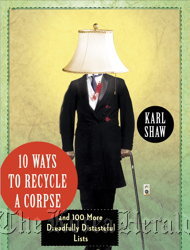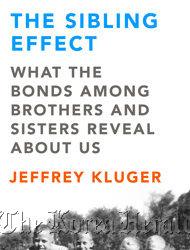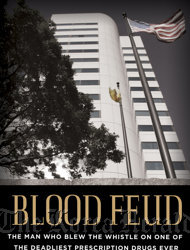Ten Ways to Recycle a Corpse: and 100 More Dreadfully Distasteful Lists
By Karl Shaw
(Three Rivers Press)

This book could be called magnetic. It pulls you in, the way a magnet pulls a paper clip, and it doesn’t want to let you go.
It recounts Julius Caesar’s attempt to cure his baldness and Cleopatra’s recommendation: the bodies of domestic mice, burnt and ground up, horse teeth mixed with bear grease, and marrow from deer bones.
That pulls you into the effects of a French king’s contrivance to mask his own loss of hair: a voluminous, powdered, curly wig. Distinguished men -- see portraits of George Washington and other Founding Fathers -- wore powdered wigs for almost two centuries. After Louis XIV comes a remedy Napoleon tried. It consisted mainly of dogs’ paws and the hooves of a certain animal.
If you read on for another 188 pages, you’ll find that Adolf Hitler -- though he didn’t make the list -- also knew of a “miracle cure” for baldness, from which he hoped to make his fortune. Ingredients and actual profitability are not given.
So don’t start “10 Ways to Recycle a Corpse” at bedtime. You may lose a lot of sleep. The book’s subtitle warns that it includes “100 More Dreadfully Distasteful Lists.”
One chapter justifies the book’s title, suggesting profitable and mostly legal ways to dispose of dead bodies. One is to sell parts to legitimate trading companies, which resell them to recognized medical organizations.
Top prices (2010) include tendons at $1,000 each. Corneas fetch $6,000 a pair, the book says, but adds that it’s illegal to sell human body fat to cosmetic firms.
Author Karl Shaw assures readers in an introduction that he has “tried in good faith to ensure that everything in this book, as far as possible, is accurate, although of course some of these ’facts’ are open to debate and interpretation.” (AP)
On sibling relationships
The Sibling Effect: What the Bonds among Brothers and Sisters Reveal About Us
By Jeffrey Kluger
(Riverhead Books)

Siblings are underrated. They provide our earliest lessons on how to conduct friendships and how to resolve conflicts. They serve as both role models and as cautionary tales. And they’re fixtures in our lives longer than our parents, spouses and children.
In “The Sibling Effect: What the Bonds among Brothers and Sisters Reveal About Us,” Time magazine science writer Jeffrey Kluger makes the convincing argument that this often overlooked relationship deserves better understanding and appreciation.
With an eminently readable and engaging style, Kluger delves into research on birth order, favoritism, squabbling, singletons, multiples and more. His attention to nuance and to pointing out weaknesses in various studies gives his credibility a boost over authors with a more evangelistic agenda.
On the hot topic of birth order, Kluger cites findings that firstborns taking personality tests tend to show a higher degree of responsibility and follow-through, while later-borns score higher on the ability to get along with people. A survey of CEOs showed that firstborns were disproportionately represented, while another study found that when later-borns become CEOs, they’re more willing to take risks and be creative.
Kluger also gives room to critics of birth order who argue that factors like economics, education and gender are much more potent, and that trying to compare families -- without taking into account their myriad differences -- is “worse than comparing apples and oranges. It’s more like comparing apples and shoes.”
It’s unusual for a book in this genre to be described as a page turner, but “The Sibling Effect” certainly qualifies as one. Peppered with illuminating anecdotes from famous siblings and from the author’s own life, this book is both enjoyable and educational -- a worthwhile read for anyone interested in human relationships. (AP)
Complicated story with human element
Blood Feud: The Man Who Blew the Whistle on One of the Deadliest Prescription Drugs Ever
By Kathleen Sharp
(Dutton)

Author Kathleen Sharp puts a human element on a complicated legal, and corporate, story in “Blood Feud: The Man Who Blew the Whistle on One of the Deadliest Prescription Drugs Ever.”
Mark Duxbury was a top salesman for Johnson & Johnson. His region was the Pacific Northwest, and he sold a drug called Procrit to many clients. Procrit was designed to help patients create red blood cells, a welcome respite for those not wanting a blood transfusion. But the side effects of heavy doses of the drug brought a terrible price.
As Johnson & Johnson fought with another company, Amgen, regarding where the drug could be sold and to which type of patients, Duxbury found himself having to secretly manipulate sales to meet his quota and not cross the corporate line. He eventually lost his job. Vowing to fight back, he decided to become a whistle-blower.
He tries to be David fighting Goliath.
The details could prove daunting and unintelligible, but Sharp makes the potentially hard to grasp easy and compelling to follow. (AP)


![[AtoZ into Korean mind] Humor in Korea: Navigating the line between what's funny and not](http://res.heraldm.com/phpwas/restmb_idxmake.php?idx=644&simg=/content/image/2024/04/22/20240422050642_0.jpg&u=)
![[Exclusive] Korean military set to ban iPhones over 'security' concerns](http://res.heraldm.com/phpwas/restmb_idxmake.php?idx=644&simg=/content/image/2024/04/23/20240423050599_0.jpg&u=20240423183955)



![[Graphic News] 77% of young Koreans still financially dependent](http://res.heraldm.com/phpwas/restmb_idxmake.php?idx=644&simg=/content/image/2024/04/22/20240422050762_0.gif&u=)
![[Herald Interview] Why Toss invited hackers to penetrate its system](http://res.heraldm.com/phpwas/restmb_idxmake.php?idx=644&simg=/content/image/2024/04/22/20240422050569_0.jpg&u=20240422150649)





![[Exclusive] Korean military to ban iPhones over security issues](http://res.heraldm.com/phpwas/restmb_idxmake.php?idx=652&simg=/content/image/2024/04/23/20240423050599_0.jpg&u=20240423183955)



![[Today’s K-pop] Ateez confirms US tour details](http://res.heraldm.com/phpwas/restmb_idxmake.php?idx=642&simg=/content/image/2024/04/23/20240423050700_0.jpg&u=)